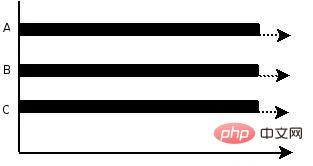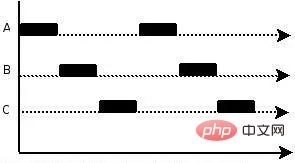What is the difference between concurrency and parallelism?
Difference: Parallelism means that multiple instructions are executed simultaneously on multiple processors at the same time; both from a micro and macro perspective, both are executed together. Concurrency means that only one instruction can be executed at the same time, but multiple process instructions are executed in rapid rotation, which has the effect of multiple processes executing at the same time from a macro perspective, but not simultaneously from a micro perspective.

Concurrency and parallelism are:
Explanation 1: Parallelism means Two or more events occur at the same time; concurrency means that two or more events occur at the same time interval.
Explanation 2: Parallelism is multiple events on different entities, and concurrency is multiple events on the same entity.
Explanation 3: Parallelism is the simultaneous processing of multiple tasks on multiple processors. For example, in a Hadoop distributed cluster, concurrency means processing multiple tasks "simultaneously" on one processor.
So the goal of concurrent programming is to make full use of each core of the processor to achieve the highest processing performance.
Parallel: refers to multiple instructions being executed simultaneously on multiple processors at the same time. So whether from a micro or macro perspective, the two are executed together.

Concurrency: refers to that only one instruction can be executed at the same time, but multiple process instructions are executed in rapid rotation, making it macroscopically The effect of multiple processes executing at the same time, but in a microscopic sense, is not executed at the same time. It just divides the time into several segments so that multiple processes can execute quickly and alternately.

Parallelism exists in multi-processor systems, while concurrency can exist in both single-processor and multi-processor systems. Concurrency can exist in single-processor systems. Because concurrency is the illusion of parallelism, parallelism requires the program to perform multiple operations at the same time, while concurrency only requires the program to pretend to perform multiple operations at the same time (performing one operation per small time slice, and quickly switching execution of multiple operations).
When there are multiple threads operating, if the system has only one CPU, it is impossible to actually run more than one thread at the same time. It can only divide the CPU running time into several time periods. , and then allocate the time period to each thread for execution. When the thread code in a time period is running, other threads are in a suspended state. This method is called concurrency (Concurrent).
When the system has more than one CPU, the thread operations may not be concurrent. When one CPU executes one thread, another CPU can execute another thread. The two threads do not seize each other's CPU resources and can proceed at the same time. This method is called parallel (Parallel).

For more related knowledge, please visit: PHP Chinese website!
The above is the detailed content of What is the difference between concurrency and parallelism?. For more information, please follow other related articles on the PHP Chinese website!

Hot AI Tools

Undresser.AI Undress
AI-powered app for creating realistic nude photos

AI Clothes Remover
Online AI tool for removing clothes from photos.

Undress AI Tool
Undress images for free

Clothoff.io
AI clothes remover

Video Face Swap
Swap faces in any video effortlessly with our completely free AI face swap tool!

Hot Article

Hot Tools

Notepad++7.3.1
Easy-to-use and free code editor

SublimeText3 Chinese version
Chinese version, very easy to use

Zend Studio 13.0.1
Powerful PHP integrated development environment

Dreamweaver CS6
Visual web development tools

SublimeText3 Mac version
God-level code editing software (SublimeText3)

Hot Topics
 1387
1387
 52
52
 Application of concurrency and coroutines in Golang API design
May 07, 2024 pm 06:51 PM
Application of concurrency and coroutines in Golang API design
May 07, 2024 pm 06:51 PM
Concurrency and coroutines are used in GoAPI design for: High-performance processing: Processing multiple requests simultaneously to improve performance. Asynchronous processing: Use coroutines to process tasks (such as sending emails) asynchronously, releasing the main thread. Stream processing: Use coroutines to efficiently process data streams (such as database reads).
 How can concurrency and multithreading of Java functions improve performance?
Apr 26, 2024 pm 04:15 PM
How can concurrency and multithreading of Java functions improve performance?
Apr 26, 2024 pm 04:15 PM
Concurrency and multithreading techniques using Java functions can improve application performance, including the following steps: Understand concurrency and multithreading concepts. Leverage Java's concurrency and multi-threading libraries such as ExecutorService and Callable. Practice cases such as multi-threaded matrix multiplication to greatly shorten execution time. Enjoy the advantages of increased application response speed and optimized processing efficiency brought by concurrency and multi-threading.
 How does Java database connection handle transactions and concurrency?
Apr 16, 2024 am 11:42 AM
How does Java database connection handle transactions and concurrency?
Apr 16, 2024 am 11:42 AM
Transactions ensure database data integrity, including atomicity, consistency, isolation, and durability. JDBC uses the Connection interface to provide transaction control (setAutoCommit, commit, rollback). Concurrency control mechanisms coordinate concurrent operations, using locks or optimistic/pessimistic concurrency control to achieve transaction isolation to prevent data inconsistencies.
 In-depth understanding of the functions and features of Go language
Mar 21, 2024 pm 05:42 PM
In-depth understanding of the functions and features of Go language
Mar 21, 2024 pm 05:42 PM
Functions and features of Go language Go language, also known as Golang, is an open source programming language developed by Google. It was originally designed to improve programming efficiency and maintainability. Since its birth, Go language has shown its unique charm in the field of programming and has received widespread attention and recognition. This article will delve into the functions and features of the Go language and demonstrate its power through specific code examples. Native concurrency support The Go language inherently supports concurrent programming, which is implemented through the goroutine and channel mechanisms.
 A guide to unit testing Go concurrent functions
May 03, 2024 am 10:54 AM
A guide to unit testing Go concurrent functions
May 03, 2024 am 10:54 AM
Unit testing concurrent functions is critical as this helps ensure their correct behavior in a concurrent environment. Fundamental principles such as mutual exclusion, synchronization, and isolation must be considered when testing concurrent functions. Concurrent functions can be unit tested by simulating, testing race conditions, and verifying results.
 How to use atomic classes in Java function concurrency and multi-threading?
Apr 28, 2024 pm 04:12 PM
How to use atomic classes in Java function concurrency and multi-threading?
Apr 28, 2024 pm 04:12 PM
Atomic classes are thread-safe classes in Java that provide uninterruptible operations and are crucial for ensuring data integrity in concurrent environments. Java provides the following atomic classes: AtomicIntegerAtomicLongAtomicReferenceAtomicBoolean These classes provide methods for getting, setting, and comparing values to ensure that the operation is atomic and will not be interrupted by threads. Atomic classes are useful when working with shared data and preventing data corruption, such as maintaining concurrent access to a shared counter.
 Golang process scheduling: Optimizing concurrent execution efficiency
Apr 03, 2024 pm 03:03 PM
Golang process scheduling: Optimizing concurrent execution efficiency
Apr 03, 2024 pm 03:03 PM
Go process scheduling uses a cooperative algorithm. Optimization methods include: using lightweight coroutines as much as possible to reasonably allocate coroutines to avoid blocking operations and use locks and synchronization primitives.
 How to avoid deadlock with concurrency and multi-threading in Java functions?
Apr 26, 2024 pm 06:09 PM
How to avoid deadlock with concurrency and multi-threading in Java functions?
Apr 26, 2024 pm 06:09 PM
Deadlock problems in multi-threaded environments can be prevented by defining a fixed lock order and acquiring locks sequentially. Set a timeout mechanism to give up waiting when the lock cannot be obtained within the specified time. Use deadlock detection algorithm to detect thread deadlock status and take recovery measures. In practical cases, the resource management system defines a global lock order for all resources and forces threads to acquire the required locks in order to avoid deadlocks.



